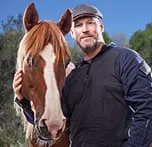
"I came from a pretty hardscrabble background," says Ronald "Jake" Clark. "My mother was institutionalized for most of my childhood, and my father had his challenges with gambling and alcohol. I spent my first couple of years in an orphanage." Toughened by those early times, 17-year-old Clark joined the Army in 1983 for 5 years, serving as an intelligence specialist in Panama, among other assignments. After stints with the Secret Service, the Los Angeles Police Department, and the FBI, he reenlisted in 2002. "9/11 really struck me. I felt compelled to try to serve in some level," he says.
But this time, service felt different. Clark returned home empty and self-destructive. And he struggled to understand why so many of his fellow veterans were committing suicide. "I wondered, 'How do you survive Iraq and Afghanistan and kill yourself back home?" he says. "I decided I had to solve this problem."
In 2012, Clark pawned two Rolex watches for $12,000 to create Save A Warrior (SAW), a Malibu, CA-based program that helps veterans recover from post-traumatic stress disorder (PTSD). The week-long residential program takes a group of 13 veterans on a healing journey that includes meditation, ropes courses, horse therapy, labyrinth walks, and counseling. Clark calls it "war detox." "We cleanse their soul so they can go back out and walk among other people."
Clark has since expanded SAW to Kansas City, MO, and Lexington, KY, and he hopes to eventually reach more of those who are at risk. "Any warrior who wants to have this experience should have this experience," he says. "These warriors deserve to live long enough to see their children comb gray hair."
Graduates of the program say Clark has saved their lives. "They're powerfully transformed from this experience," Clark says. "I'd like to be one of those guys who's on the winning side of suicide. I know what it's like to not want to be here."
Update: Changes Afoot for Save A Warrior
The program's current digs in Malibu are great, Clark says, but they're just not available as often as he needs them. That's why the organization is laying down plans for a new home in the Pacific Northwest. The village will offer a permanent location for the 5 1/2 day retreat.
Plus, he says, "When you have a facility like that, it changes your level of credibility." It allows outside organizations to come in and study your work. To that end, researchers from the University of Kansas plan to conduct a retrospective study of SAW participants.
They'll take a deep dive with program alumni and publish the results, Clark says.
Despite the expansion plans, don't expect to see the country dotted with SAW franchises. Clark describes the organization as "boutique" and says he plans to keep it that way.
"I don't think we'll ever serve more than a handful of a hundred returning warriors a year."
Instead, he helps other groups build SAW-like programs that work for them, whether it's local veterans groups or first responder/law enforcement groups. He recently got a call from the Royal Canadian Mounted Police looking to get help for an officer.
"Right now there's 12 programs in this country that are derivative of SAW. So we're really pleased about that," Clark says.
He also plans to put technology to use to help distant vets or those who want to keep their identities secret because they've served in special operations forces.
"I'm looking at some interesting aspects that involve virtual or augmented reality so you can project the provider into the space," Clark says.
In the meantime, you can catch SAW's efforts on the screens both big and small. First up: The War Comes Home, a Soledad O'Brien special report for CNN from 2014. The film followed returning vets through a portion of the SAW program.
A new documentary released late last year, Thank You for Your Service, also sheds light on the mental health concerns returning vets face. It features input from heavy hitters of the post-9/11 era like former Defense Secretary Robert Gates, retired Gen. David Petraeus, former New York Mayor Rudy Giuliani, and actor Gary Sinise. The film concludes with a sojourn at SAW.
It follows a few warriors who have this transformative experience before they try to go back out and take on the world again, and maybe come at it from a different perspective, Clark says. "The ones featured in the film had incredible turnarounds in their lives."
And that, in a nutshell, is the measure of success Clark seeks for all who find their way to Save A Warrior.